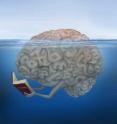Hebrew University researchers show how we can do math problems unconsciously
Can we actually read words and phrases and solve multi-step mathematical problems without our having consciously been aware of them? A team in the Psychology Department at the Hebrew University has conducted a series of experiments that give a positive answer: people can read and do math non-consciously. The results constitute a challenge to existing theories of unconscious processes, that maintain that reading and solving math problems -- two prime examples of complex, rule-based operations -- require consciousness.
The conclusions of the Hebrew University team were published this week in PNAS (Proceedings of the National Academy of Sciences) in the US. The research team, headed by Dr. Ran Hassin, included graduate students Asael Sklar, Ariel Goldstein, Nir Levy and Roi Mandel, as well as Dr. Anat Maril.
To present sentences and equations unconsciously, the researchers used a cutting-edge technique called Continuous Flash Suppression (CFS). In CFS, one eye is exposed to a series of rapidly changing images, while the other is simultaneously exposed to a constant image. The rapid changes in the one eye dominate consciousness, so that the image presented to the other eye is not experienced consciously. Using this technique, more than 270 students at the Hebrew University were exposed to sentences and arithmetic problems.
In one set of experiments using this technique, participants were asked to pronounce numbers that appeared on a computer's screen. These numbers were preceded with unconscious arithmetic equations. The results of the experiments showed that participants could more quickly pronounce the conscious number if it had been the result of the unconscious equation. For example, when 9-5-1 was shown non-consciously, the participants were faster in pronouncing 3 than 4, even though they did not consciously see the equation.
In another set of experiments reported in the PNAS paper, participants were non-consciously exposed to a number of short verbal expressions that remained on screen until participants could say that they saw them. (In the meantime, the other eye was exposed to the rapidly flashing images). The results showed that negative verbal expressions (e.g., human trafficking) or unusual phrases (e.g., the bench ate a zebra) became conscious to the viewers before more positive expressions (e.g., ironed shirt and more usual phrases (e.g., the lion ate a zebra), indicating a definite "pickup" by the unconscious of something negative and out of the ordinary.
"These results show that the humans can perform complex, rule-based operations unconsciously, contrary to existing models of consciousness and the unconscious," say the researchers.
"Therefore," said Dr. Hassin, "current theories of the unconscious processes and human consciousness need to be revised. These revisions would bring us closer to solving one of the biggest scientific mysteries of the 21st century: What are the functions of human consciousness."
Source: The Hebrew University of Jerusalem
Other sources
- Unconscious brain can do math, readfrom MSNBC: ScienceThu, 15 Nov 2012, 18:30:59 UTC
- Who Needs Consciousness? We Can Read and Do Math Without Being Awarefrom Live ScienceWed, 14 Nov 2012, 20:02:23 UTC
- People can read and solve multi-step math problems non-consciouslyfrom Science DailyWed, 14 Nov 2012, 17:32:19 UTC
- Not what you consciously thought: How we can do math problems and read phrases nonconsciouslyfrom Science DailyWed, 14 Nov 2012, 14:02:14 UTC
